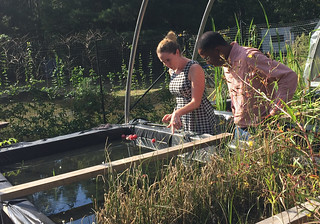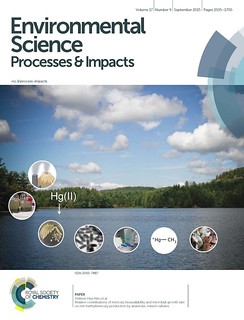
Methylmercury (MeHg) is a potent neurotoxin that biomagnifies in aquatic food webs and poses a health risk for people and wildlife. Anaerobic microorganisms such as sulfate reducers, iron reducers and methanogens are primarily responsible for converting inorganic forms of Hg to MeHg. Thus, the production of MeHg by anaerobic microbes and the bioavailability of inorganic mercury to these microbes are critical initial steps towards MeHg bioaccumulation in fish and other high trophic-level species.
In our group, we investigate the relationship between geochemical forms of Hg in contaminated ecosytems and microbial methylation potential, a poorly understood relationship that hinders progress towards effective site management. The ‘age’ of mercury after initial input from the source point is a factor that reduces bioavailability over time. A known aging process for mercury in sediments is the precipitation of sulfide minerals (i.e., HgS(s) metacinnabar). Our previous research has shown that nanoparticles of HgS can form as stable intermediates of slow precipitation reactions. These nanoparticles, especially amorphous phases, are inherently more soluble than bulk minerals and can be more bioavailable than larger particles at microbial interfaces.

The objective of our work is to investigate biogeochemical processes that control the bioavailability of mercury and identify methods to assess the methylation potential of mercury in contaminated sediments. In particular, we are quantifying the relationship between Hg-sulfur coordination states and the availability of the metal for microorganisms. We are also applying biomolecular tools to study the diversity and relative abundance of Hg-methylating microorganisms in anaerobic microbiomes of aquatic ecosystems. Our goals are to develop quantitative and predictive relationships that describe the geochemical and microbiological contributions to mercury methylation potential in the environment. We are interested in applying these capabilities towards improved management of contaminated sites and development of remediation strategies.
Recent papers:

Ambio Synthesis Paper (2018) (open access),
Nanoscale mercury sulfides: ES&T (2009) , (2012), (2014), (2019) (2023) ;GCA (2014) ; ESPI 2023
Mercury methylation potential: ES&T Review article (2013), ESPI (2015); ES&T (2019)
Methods to quantify mercury bioavailability: EES (2015), ES&T (2015) , (2018), (2022)
This research is currently supported through grants from the Department of Energy and the Superfund Research Program with the National Institute of Environmental Health Sciences.
Recent papers:
Koenigsmark, Faye, Nelson A. Rivera, Eric M. Pierce, and Heileen Hsu-Kim. (2023) “Dissolution Potential of Elemental Mercury in the Presence of Bisulfide and Implications for Mobilization.” Environ. Sci. & Technol. 57, 12388–97. https://doi.org/10.1021/acs.est.3c00694.
Koenigsmark, Faye, Michelle Chiu, Nelson Rivera, Alexander Johs, Jeremy Eskelsen, Donovan Leonard, Boakai K. Robertson, et al. “Crystal lattice defects in nanocrystalline metacinnabar in contaminated streambank soils suggest a role for biogenic sulfides in the formation of mercury sulfide phases.” Environmental Science: Processes & Impacts, 25, 445–60. https://doi.org/10.1039/d1em00549a.
Rivera, N.A.; Bippus, P.M.; Hsu-Kim, H. (2019). Relative Reactivity and Bioavailability of Mercury Sorbed to or Coprecipitated with Aged Iron Sulfides. Environ. Sci. & Technol. 53, 7391-7399. DOI: 10.1021/acs.est.9b00768
Neal-Walthall, Natalia, Udonna Ndu, Nelson A. Rivera, Dwayne A. Elias, and Heileen Hsu-Kim. “Utility of Diffusive Gradient in Thin-Film Passive Samplers for Predicting Mercury Methylation Potential and Bioaccumulation in Freshwater Wetlands.” Environ. Sci. & Technol., 56, 1743–52. https://doi.org/10.1021/acs.est.1c06796
Hsu-Kim, H.; Eckley, C.S.; Achá, D.; Feng, X; Gilmour, C.C.; Jonsson, S.; Mitchell, C.P.J. (2018). Challenges and Opportunities for Managing Aquatic Mercury Pollution in Altered Landscapes. Ambio. 47(2): 141-169. DOI: 10.1007/s13280-017-1006-7
Ndu, U.; Christensen, G.A.; Rivera, N.A.; Gionfriddo, C.M.; Deshusses, M.A.; Elias, D.A.; Hsu-Kim, H. (2018). Quantification of Mercury Bioavailability for Methylation Using Diffusive Gradient in Thin-Film Samplers. Environ. Sci. & Technol. 52, 8521-8529. DOI: 10.1021/acs.est.8b00647
Kucharzyk, K.H.; Deshusses, M.A.; Porter, K.A.; Hsu-Kim, H. (2015). Relative contributions of mercury bioavailability and microbial growth rate on net methylmercury production by anaerobic mixed cultures. Environ. Sci.: Processes & Impacts. 17, 1568-1577. DOI: 10.1039/C5EM00174A.
Zhang, T.; Kucharzyk, K.H.; Kim, B.; Deshusses, M.A.; Hsu-Kim, H. (2014). Net methylation of mercury in estuarine sediment microcosms amended with dissolved, nanoparticulate, and microparticulate mercuric sulfides. Environ. Sci. & Technol. 16, 9133-9141. DOI: 10.1021/es500336j.
Pham, A. L.-T.; Morris, A., Zhang, T., Ticknor, J.; Levard, C.; Hsu-Kim, H. (2014). Precipitation of Nanoscale Mercuric Sulfides in the Presence of Natural Organic Matter: Structural Properties, Aggregation, and Biotransformation. Geochim. Cosmochim. Acta. 133, 204-215. DOI: 10.1016/j.gca.2014.02.027.
